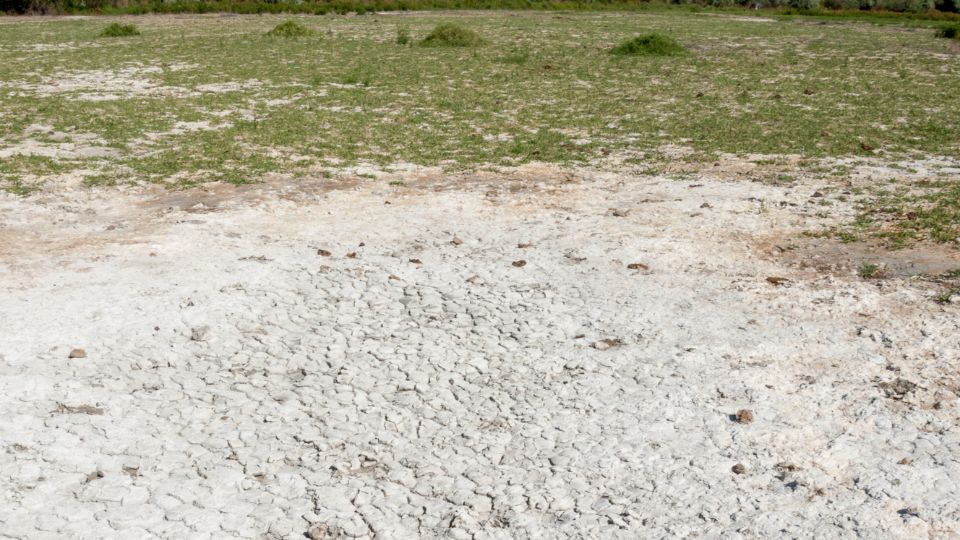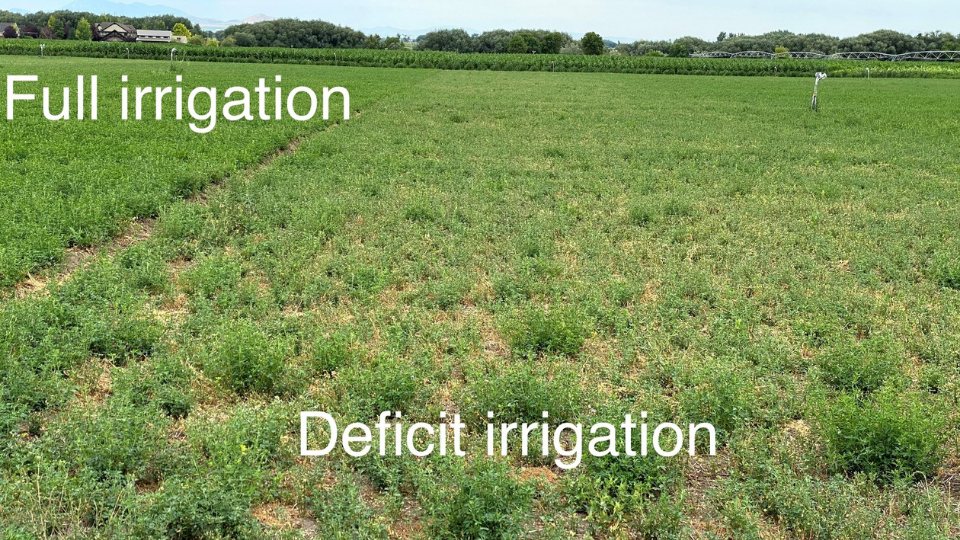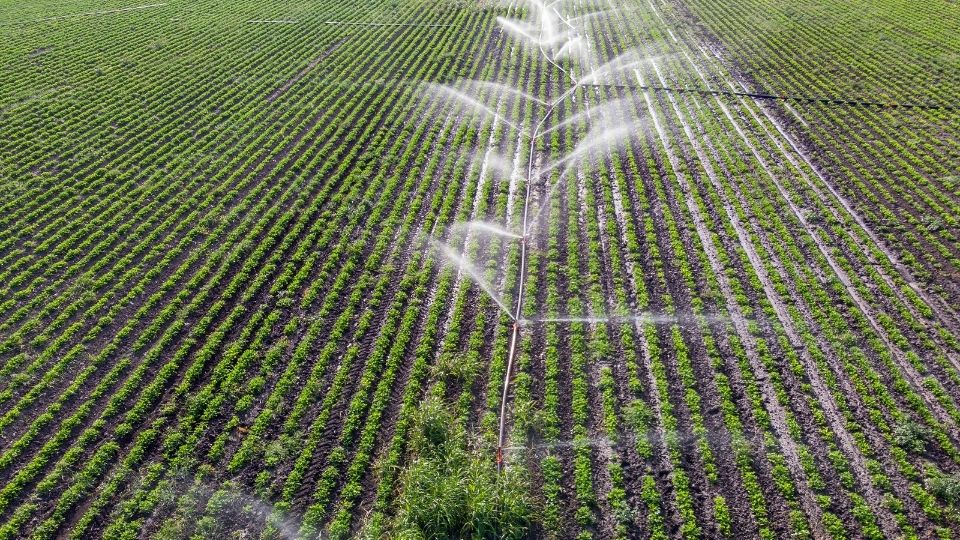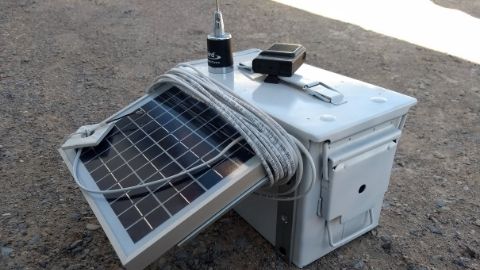Drought Tolerance Guide for Corn in Utah
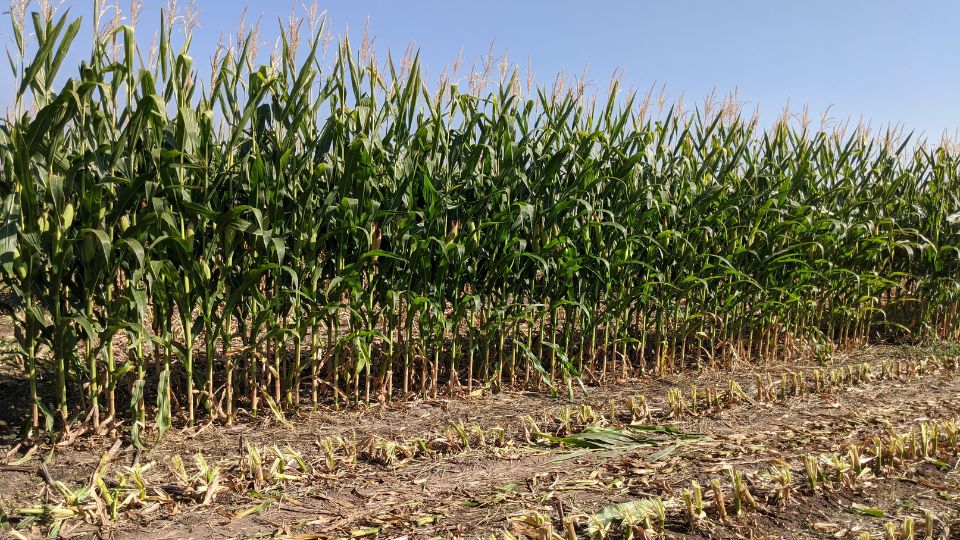
Overview
Crop variety selection is one of the most important choices on the farm. Crop genetics determine a significant portion of the yield potential and resource use efficiency. Crop types and genetics that use water more efficiently will become increasingly important as water becomes scarcer. Throughout Utah and the Western United States, water availability is decreasing due to various factors, including reduced snowpack andrapid urban growth. Alfalfa, other hay, small grains, and corn are grown on more acres than any other crops in Utah and much of the Intermountain West. These crops all have varieties, hybrids, and cultivars with the potential for more efficient water use while mitigating yield loss. Navigating these options and understanding various mechanismsand effectiveness can be a challenge. This guide will address some of the primary mechanisms, options, and effectiveness of crop genetics for improved water use efficiency.
Highlights
- In five Utah trials, a corn hybrid genetically modified for drought tolerance has not consistently yielded better or been more profitable than conventional hybrids in full irrigation or drought-stress conditions.
- Crop genetics for drought tolerance have shown few water-saving benefits in Utah and should be considered with caution until more research confirms their profitability.
What Is Water Use Efficiency?
As water is a limitation in crop production, the need for crops to use every applied and natural (i.e., precipitation) unit of water is a high priority. One definition of crop water use efficiency (WUE) is the biomass or grain yield produced per unit of the total water used by the crop. It is calculated as WUE = Y/ET, where Y is the crop yield, either in total harvestable biomass or marketed yield, and ET is the combined water evaporation from the soil surface and water transpired by plants (Hatfield et al., 2001).
Water use efficiency is influenced by many factors, including soil and climate conditions. Crop type, management, and genetics also heavily influence WUE. Although WUE can vary widely, commonly reported values for major grain crops range from about 275 pounds of grain per acre inch of water for corn to 500 pounds of grain per acre inch of water for wheat (Putnam et al., 2001; Sadras & Angus, 2006). Alfalfa is about 300 pounds of biomass per acre inch of water. Silage corn and small grain forages have among the highest reported WUE. Silage corn has WUE of about 910 pounds per acre inch, and wheat forage has a value of about 700 pounds of dry matter per acre inch (Nilahyane & Islam, 2018; Marsalis, 2018).
Another factor to consider when evaluating efficiency is the harvest index. The harvest index is the percentage of the above-ground biomass harvested (Putnam et al., 2001). Because the complete leaf and stem are collected, alfalfa has a harvest index of 100. This is compared to grain corn with a harvest index of 50 or wheat with an index of 45. This increases the efficiency of alfalfa because all water used in the above-ground biomass is harvested compared to grain production, where half the biomass is unharvested. For this reason, silage corn and forage grains also have a higher harvest index and WUE. Several ongoing genetic and management efforts exist to improve the water use efficiencies of these crops.
Drought-Tolerant Hybrids
Improved WUE and drought-tolerance efforts for corn have included crop breeding and genetic modifications. Corn has had more genetic modification than most other crops, including improvements for enhanced drought tolerance. Drought-tolerant corn varieties were available on the market beginning in 2013 (McFadden, 2019). Various seed breeding companies have developed different varieties of drought-tolerant corn, making the choice for the producer more complex. Table 1 summarizes a few of the available drought-tolerant traits, the seed company producing them, and their main development pathway.
Table 1. Some Available Drought-Tolerant Corn Hybrid Types
| Seed company | Trait name | Conventional/GMO | Modified trait or characteristic |
|---|---|---|---|
| Bayer | DroughtGard® | GMO |
|
| Syngenta | Artesian® | Conventional |
|
| Corteva | Optimum® AQUAmax® |
Conventional |
|
Drought Varieties
The DroughtGard® trait, produced by Bayer, usesbiotechnology to offer a defense against the weather as it becomes increasingly unpredictable (Ciampitti et al., 2017). This technology involves inserting a stress response gene into the genetic sequence. This gene allows for continued protein production in the plant that traditionally would have been halted when moisture levels drop below manageable amounts. Protein production is essential for plant growth and DroughtGard technology was designed for growth stability in drought conditions (Bayer, 2017).
Syngenta’s Artesian® is a conventionally bred corn line for drought tolerant vigor. The hybrid has five improved areas to help ensure minimal yield loss during dry periods. The plants better regulate pollen shed and silking resulting in successful fertilization and kernel development. Better resource allocations within the plant have been studied to increase the volume of harvestable grain per ear. The plant can better maintain normal growth and development longer during periods of drought stress, limiting wilting and curling. These hybrids have also optimized the growth and health of developing roots, shoots, and floral tissues (Agrisure Artesian, 2015).
Similar to Artesian, Optimum® AQUAmax® by Corteva is another traditionally bred hybrid line of high-producing drought-tolerant corn. The key trait areas bred for these hybrid lines are improved root systems, competitive silk emergence, and optimized stomal closure. The hybrids are adapted to withstand and maintain yield in drought conditions or remain competitive in nature to other hybrids in a normal environment (Dupont Pioneer, 2013).
Drought Trials
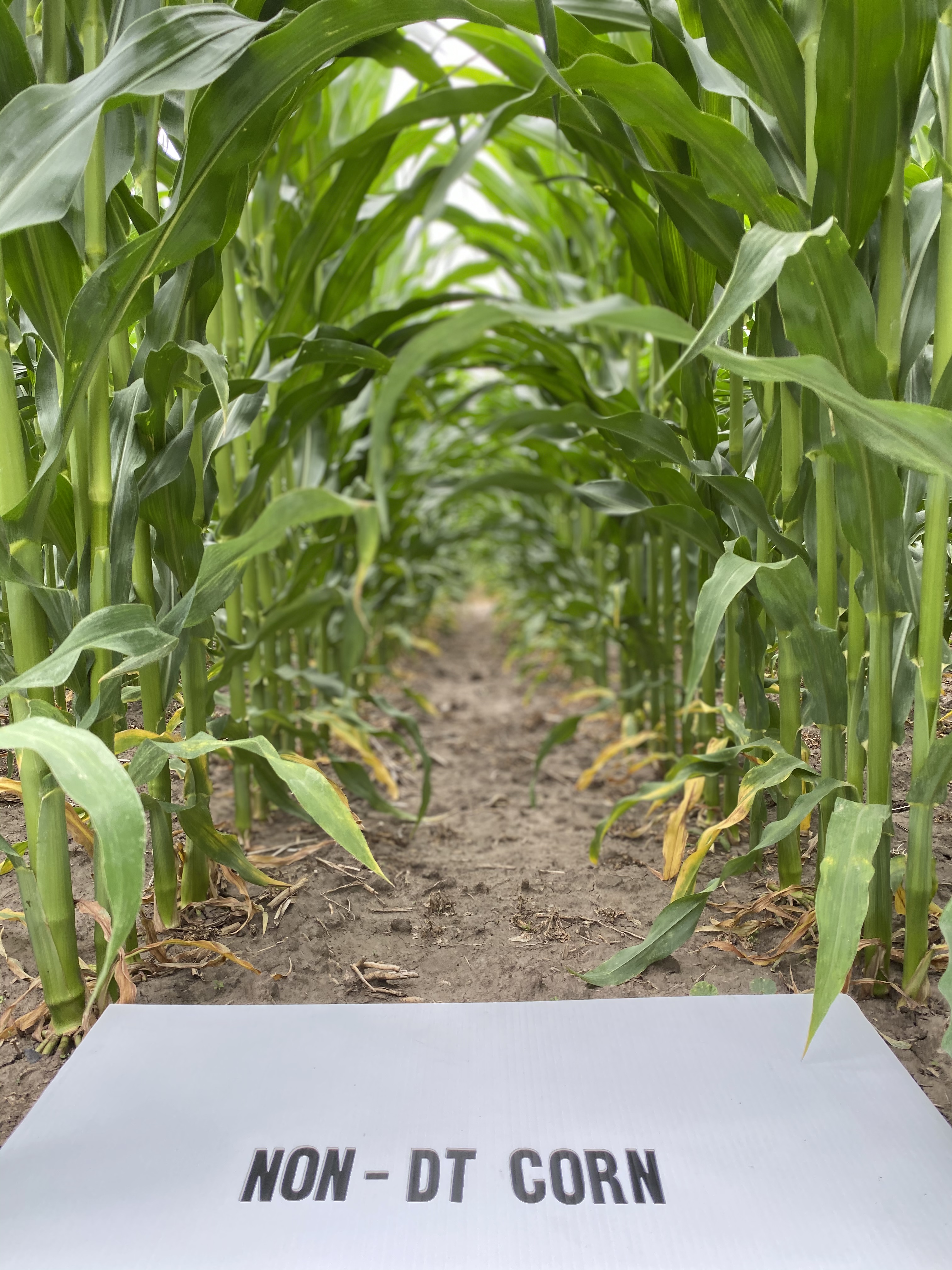
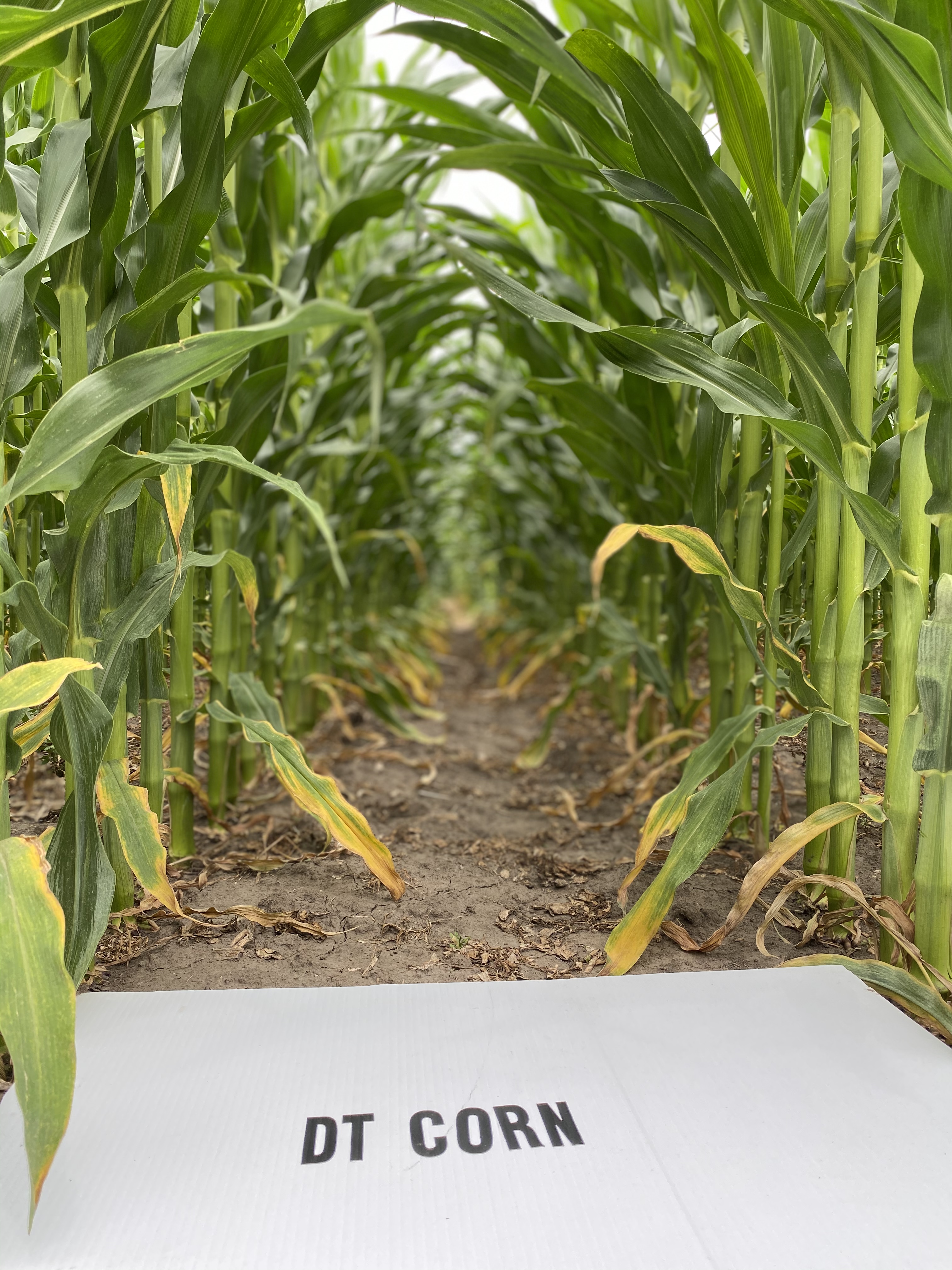
Corn water optimization trials were conducted at the same three locations (Logan, Vernal, and Cedar City) as the alfalfa drought-tolerance trials described above from 2019 to 2021. This work has produced five trials of data on the comparison of drought-tolerant and non-drought-tolerant corn hybrids at full and reduced irrigation rates (100%, 75%, and 50%). Comparing a hybrid bred for drought tolerance to a non-drought-tolerant hybrid is difficult because the breeding process usually results in different characteristics of the hybrid (such as day length, pest and disease resistance, etc.). Thus, we elected to use a drought-tolerant hybrid developed with genetic engineering in order to compare two hybrids that were as similar as possible.
In the research trials, we compared two DeKalb hybrids each year at each site. The drought-tolerant hybrid was as similar as possible in all traits (Roundup Ready®, 94to 96-daylength, and pest resistances) to the non-drought-tolerant hybrids, with the exception of the inserted DroughtGard® gene in the drought-tolerant hybrid (Figure 4). The hybrid pairs (non-and drought-tolerant) changed after 2019 because some hybrids were nolonger available. This resulted in DKC 51-20 as the drought-tolerant and DKC 50-84 as the non-drought-tolerant in 2019 at Logan.DKC 47-27 was the drought-tolerant hybrid and DKC 46-36 was the non-drought-tolerant hybrid in the other four trials. During 2019 and 2020, the price of the corn seed was about $288 per bag (80,000 seeds) for the non-drought-tolerant and $305 per bag for the drought-tolerant hybrid. Thus, assuming a bag could plant about two acres, the drought-tolerant hybrid cost about $8.50 more per acre than the non-drought-tolerant hybrid.
Figure 5 shows the corn silage yields per site year. Drought-tolerant silage corn yielded on a dry matter basis 5.9 to 16.5 tons per acre while the conventional genetics yielded 7 to 16.3 tons per acre. The lowest yield occurred in Vernal in 2021 due to a water shortage that resulted in an early harvest in August. Despite the variation in yield among sites and years, there was never a significant difference in corn silage yield between the drought-tolerant genetics and conventional genetics. This was true at the full irrigation rate and all reduced rates. Thus, all the data shown were averaged across irrigation rates for simplicity.
Figure 6 shows silage corn protein values were affected by corn genetics in three of the five trials where the drought-tolerant hybrid increased protein by 3% to 8%. Values ranged from 20.7%to 24.9% with conventional genetics and 21.3% to 25% with drought-tolerant genetics. Starch values were affected by corn genetics in two of the five trials. At Vernal in 2020, starch was 4% higher with drought-tolerant genetics, and the following year, starch was 2% higher using drought-tolerant genetics (Figure 7). Total digestible nutrients (TDN) had significant differences for three site years, with the conventional genetics producing higher values than the drought-tolerant hybrid (Figure 8). At Logan in 2020, the conventional hybrid had 9% greater TDN than the drought-tolerant hybrid. For Vernal in 2020, there was a 10% advantage with the conventional hybrid, and 2021 had a 19% difference, with the conventional hybrid producing 15.9% and the drought-tolerant at 12.9%.




Results from these five trials indicate that the genetically modified drought-tolerant hybrids provide little to no consistent advantage in terms of yield and forage quality over similar non-drought-tolerant hybrids. The exception was that the drought-tolerant hybrid improved silage corn protein in4 of 5 trials (Figure 6). However, this improvement in protein occurred with full and deficit irrigation,so it is not specific to drought conditions.
While our Utah trials did not result in consistent increases in crop yield from the use of drought-tolerant varieties, a Kansas trial indicated different results. Drought-tolerant varieties performed better with environmental stressors and were competitive in yield with non-drought varieties when water was not limiting. Across nearly 350 corn trials, drought-tolerant varieties commonly outyielded non-drought varieties by 5 to 15 bushels per acre (Ciampitti et al., 2017). As the yield of the non-drought-tolerant varieties decreased, the yield advantage of drought-tolerant varieties increased. Thus, there is likely situations in Utah and the West were drought-tolerant corn hybrids can increase yield and quality in water-stressed conditions, but we have not been able to detect them yet in our trials. This drought-tolerant hybrid technology does come with a cost. As stated earlier, drought-tolerant corn hybrids increase seed costs by about $8-10 per acre (McFadden, 2019). Thus, ensuring recovery of this added cost when investing in drought-tolerant genetics is a principle question that will drive future Utah research.
Summary
As drought becomes more common and intense in many regions, it is essential that options for drought tolerant crop varieties be explored and considered for growing areas affected by drought. Continued research is being conducted on the performance of drought tolerant varieties and hybrids, specifically in the West. Five Utahstudies comparing conventional and drought tolerant corn hybrids have shown little to no consistent increase in crop yield and performance of the drought-tolerant hybridsin contrast to conventional hybrids. Therefore, drought tolerant options should be considered carefully until further research can locally verify that the agronomic benefits outweigh the added cost.
References
- Agrisure Artesian. (2015). Maximize yield when it rains and increase yield when it doesn’t. Syngenta. https://www.syngenta-us.com/prodrender/imagehandler.ashx?ImID=4a142 589-1e3c-48af-8cc2-91492d8dc2c5&fty=0&et=8.
- Bayer. (2017). DroughtGard hybrids. https://traits.bayer.com/corn/Pages/DroughtGard-Hybrids.aspx#:~:text=DroughtGard%20Hybrids%20technology%20utilize%20a,occuring%20soil%20bacterium%2C%20Bacillus%20subtilus.
- Ciampitti, I., Adee, E., Roozeboom, K., Schlegel, Al, Cramer, G., Duncan S., & Shoup, D. (2017). Drought-tolerant corn hybrids: Yield benefits [Fact sheet]. Kansas State University Agricultural Experiment Station and Cooperative Extension Service. https://www.bookstore.ksre.ksu.edu/pubs/MF3338.pdf.
- Dekalb (2021). Seed guide. Bayer. http://devolderfarms.com/wpcontent/uploads/2020/11/2021-DEKALB-Seed-Guide-ECAN.pdf.
- Dupont Pioneer Optimum Aquamax. (2013). Harvest more bushels per drop. https://www.pioneer.com/cmroot/pioneer/canada_en/products/seed_trait_technology/OptimumAQUAmaxInfographic_2013ca.pdf.
- Hatfield, J., Sauer, T., & Prueger, J. (2001). Managing soils to achieve greater water use efficiency: A review. Agronomy Journal, 93, 271–280. https://pubag.nal.usda.gov/catalog/13003.
- McFadden, J. (2019). Development, adoption, and management of drought-tolerant corn in the United States. U.S. Department of Agriculture. https://www.ers.usda.gov/amber-waves/2019/march/drought-tolerant-corn-in-the-united-states-research-commercialization-and-related-crop-production-practices/.
Other Resources
- Croplan 2022 Seed Guide. (2022). Winfield United. https://www.winfieldunited.com/Winfield/media/images/WFU-Seed/2022_CROPLAN_Seed_Guide_Final_All_Crops.pdf.
- NK.(2022). NK seed guide. Syngenta. https://www.syngenta-us.com/seeds/seed-guides/nk.
- Nilahyne, A., & Islam, A. (2018). Different irrigation systems and nitrogen rates improve yield and water use efficiency of corn silage [Fact sheet]. University of Wyoming Extension. http://wyoextension.org/publications/html/B1326/.
- Renk Seed. (2021). Seed catalog. https://www.readkong.com/page/2021-seed-catalog-renk-seed-5430049.
- Schick, B., & Beckman, B. (2020). Fermenting for forages: Small grain silage. UNL Beef. https://beef.unl.edu/beefwatch/2020/fermenting-forages-small-grain-silage.
Published August 2022
Utah State University Extension
Peer-reviewed fact sheet
Authors
Matt Yost, Tina Sullivan, Dakota Boren, LuRee Johnson, Melanie Mills, Earl Creech, Boyd Kitchen, and Randall Violett
Related Research















